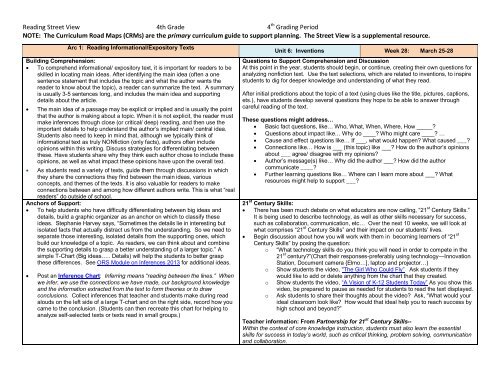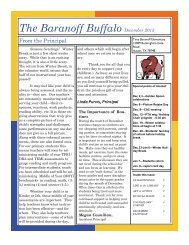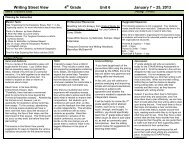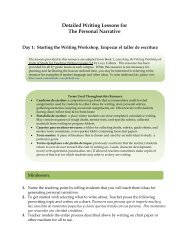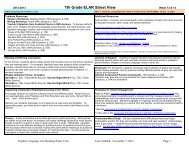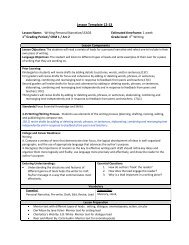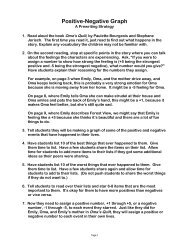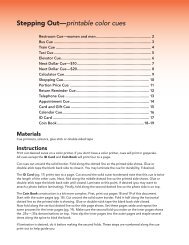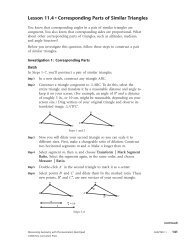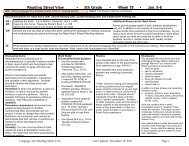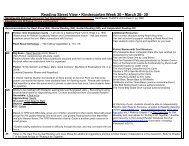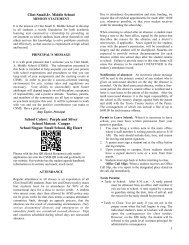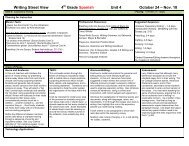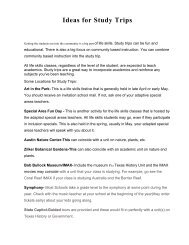Reading Street View 4th Grade 4th Grading Period NOTE: The ...
Reading Street View 4th Grade 4th Grading Period NOTE: The ...
Reading Street View 4th Grade 4th Grading Period NOTE: The ...
- No tags were found...
You also want an ePaper? Increase the reach of your titles
YUMPU automatically turns print PDFs into web optimized ePapers that Google loves.
<strong>Reading</strong> <strong>Street</strong> <strong>View</strong> <strong>4th</strong> <strong>Grade</strong> 4 th <strong>Grading</strong> <strong>Period</strong><strong>NOTE</strong>: <strong>The</strong> Curriculum Road Maps (CRMs) are the primary curriculum guide to support planning. <strong>The</strong> <strong>Street</strong> <strong>View</strong> is a supplemental resource.Arc 3: <strong>Reading</strong> Poetry Unit 6: Inventions Week 30: April 8 - 12Building Comprehension:Poetry uses words, phrases, and sentences (and sometimes longer combinations ofall) to create meaning. Poetry can be nonfiction – a poem written about anoutstanding individual or a heroic time, for example. Writers can also publish theirmemoirs and autobiographies as poetry. <strong>The</strong> important thing about poetry is how itstrives to speak to the heart. Poetry also offers opportunities for manyinterpretations. (Remember that the students will be seeing it from a perspectiveother than your own… value these perspectives so they will learn that one half ofunderstanding text is the writer’s message, the other half is the reader’s take on it.Poetry: supports the engagement of emotions, evokes sensory images, lends itself to reading aloud, often uses figurative language incorporates rhythm and sometimes rhyme, captures deep meanings often in few words from which the reader must makeinferences and connections in order to truly make meaning of poetry.For a deeper understanding, see the following module: Poetry StudyModuleThis poetry module includes the structural elements of poetry (e.g., rhyme,meter, stanzas, line breaks) relate to form (e.g., lyrical poetry, free verse). <strong>The</strong>STAAR test will also ask inference and theme questions about poetry.Anchors of Support:Post poems in the classroom (or in a poetry notebook)Have students help you to label the form of each poem and explain thedistinguishing characteristics.Provide students with many copies of poems so they can read and rereadduring independent reading.Poetry terms and definitions/examplesPoets often use “flowery” language with which students may not be familiar. Reviewuse of various dictionaries to support understanding. It helps to display a chart ofhow to find words and understand the pieces of a dictionary entry.Questions to Support Comprehension and Discussion about Poetry:One way to get the, “biggest bang for your buck” from your teaching is to focus on askingopen-ended questions throughout every component of your literacy block. When planningaround a piece of text, plan stopping points and questions beginning with these stems:Stems for Open-Ended Questions- Describe - Explain - What - How - Why - Tell me aboutAsking your students questions that begin with these words serve multiplepurposes: Students must expand on answers Students must explain their thinking It ultimately pushes students to provide evidence from the text. Questions provide frames to support discussion.<strong>The</strong>me: What is a theme? What are some examples of themes you might find in poetry? What important themes can you identify in this poem? What other stories, dramas, poems have we read that have the same themes? How are the title and theme of the poem related?21 st Century Skills: This week, continue the discussion about 21 st Century Skills that you began with yourstudents in week 28 by extending it to put expectations in place for this week ofpoetry. Tell students that part of developing 21 st Century Skills is to be able to work in a groupproductively and with accountability. Between now and the end of the year, they willbe working in groups to deepen their knowledge of reading and writing.” Divide students into collaborative groups and introduce the goals of Productivity andAccountability (see bullets below). How are results for group projects going to becalculated? (i.e. How is credit going to be distributed? Will everyone get equalcredit?) In their groups, have them “study” three to four related poems and create some typeof visual representation of the similarities and differences between the poems. (Thismight be paper and pencil, a dramatic representation, or using electronic technologylike a web with Inspiration ®, a PowerPoint ® slide show, a short iMovie…)
<strong>Reading</strong> <strong>Street</strong> <strong>View</strong> <strong>4th</strong> <strong>Grade</strong> 4 th <strong>Grading</strong> <strong>Period</strong><strong>NOTE</strong>: <strong>The</strong> Curriculum Road Maps (CRMs) are the primary curriculum guide to support planning. <strong>The</strong> <strong>Street</strong> <strong>View</strong> is a supplemental resource.Arc 4: <strong>Reading</strong> Procedural Texts Unit 6: Inventions Weeks 31 & 32: April 15 – 26Building Comprehension:Questions to Support Comprehension and Discussion:A procedural text tells how to do something. All procedural texts have certain elements in <strong>Reading</strong> Procedural Text:common. Sometimes there is a list of materials. <strong>The</strong>re is always a list of steps (often How do the structural elements of procedural texts help you to betternumbered) for readers to follow. Sometimes authors of procedural texts use sequence words: understand what you are reading?first, next, then, last. Procedural texts also often have pictures, illustrations, diagrams, or What do writers of procedural text do that help to influence or impact acharts. <strong>The</strong>se graphic features help readers visualize what the text describes or explains.reader’s understandings?See <strong>Reading</strong> Genres: A Study Guide, Unit 3, pp. 9-12 When does the author elaborate on steps of the procedure? Notice the language used in the different procedural text examples. Identify any technical How does the author help you to “see” what they are explaining?words used. Discuss the meaning of any words common to the examples used. Discuss What was the author’s purpose in writing this text?any affixes used in the text and review prior examples. Encourage students to write What was the main idea and what are the details in the message?academic vocabulary specific to any text type and provide opportunities for discussion. What text features were used to convey the author’s message? What was the purpose of each text features used? Focus discussions on the text features specific to procedural writing, along with how it often Often, procedural text is an embedded piece of a larger text. With theseenhances a longer expository text. (Remember it is more important for them to understand texts, you might ask questions like…the functions of procedural text than to identify it as “procedural text.”) Why did the author explain how to _______ in the middle of this other text? Vocabulary: discuss the use of context to decode unfamiliar words (which occur frequently Did the procedural part of the text make sense with the rest of the story/in procedural text.)passage/ text? Explain why or why not.Anchors of Support:When reading nonfiction texts, readers’ eyes catch the striking illustrations, realisticphotographs, bold headings, and telling subtitles. <strong>The</strong>se features of nonfiction alert thereader to important information. <strong>The</strong>se features include: fonts and special effects (titles,bold print, color print, italics, bullets, captions, and labels. <strong>The</strong>y may also include graphics,such as diagrams, cutaways, maps, word bubbles, tables, charts, and graphs. Studentsshould review and discuss text features before, during and after reading.Post examples of procedural text. Label different text features and identify why author usedthose features. Compare different procedural texts to identify all the features that authorsuse to create meaning.Create an anchor chart identifying a variety of types of procedural texts, along withstrategies to help us understand them.21st Century Skills:Most students will be preparing for the STAAR Assessment, but this will oftenbe addressed in small teacher-led groups. As these groups meet, remainingstudents can be working on this mini-project that will help them prepare bydigging deeper into text.A simple way for students to practice understanding procedural text structure isto create a short PowerPoint slideshow to teach someone else how to dosomething. If you are not comfortable with PowerPoint, see the tutorials atAtomic Learning to prepare you for this.http://www.atomiclearning.com/k12/home Click “Tutorials,” and then find“PowerPoint” in the pull down menu for Applications. Choose the version ofPowerPoint that’s on your computers and view the short tutorials that will helpyou use the program.Teacher Information: From Partnership for 21 st Century Skills:Manage Projects: Set and meet goals, even in the face of obstacles andcompeting pressures; Prioritize, plan and manage work to achieve theintended resultProduce Results: Demonstrate additional attributes associated with producinghigh quality products including the abilities to: Work positively and ethically;Manage time and projects effectively; Multi-task; Participate actively, aswell as be reliable and punctual; Present oneself professionally and withproper etiquette; Collaborate and cooperate effectively with teams
<strong>Reading</strong> <strong>Street</strong> <strong>View</strong> <strong>4th</strong> <strong>Grade</strong> 4 th <strong>Grading</strong> <strong>Period</strong><strong>NOTE</strong>: <strong>The</strong> Curriculum Road Maps (CRMs) are the primary curriculum guide to support planning. <strong>The</strong> <strong>Street</strong> <strong>View</strong> is a supplemental resource.Arc 1: <strong>Reading</strong> to Make Connections Between Different Genres (Expository andDrama-Tall Tale) & Arc 2: Making Connections Between Different Genres (Hist.Fiction and Drama- Historical)Building Comprehension:Students should now be leading most of their conversations about what they arereading. Using the Social Studies text is a great way to enhance this unit “LearningFrom History.” Find articles that connect with your other reading selections, alongwith encouraging the students to use the text as a resource for the research reportthey are writing (as applicable).ReadWriteThink has several teacher resources and lesson plans focusing on TallTales as well as a great lesson supporting research with two texts- Beyond HistoryBooks: Researching With Twin Texts and Technology.Anchors of Support:<strong>The</strong> Character Study Matrix from the ReadWriteThink lesson American Folklore: AJigsaw Character Study provides a great organizing tool for comparing charactersbetween texts.<strong>The</strong> graphic organizer Making Connections provides a tool to support strugglingstudents with making connections. <strong>The</strong> link includes additional suggestions forteachers.As the year ends, be sure to cycle back through your best anchors of support forreading. this will refresh the concepts in the students’ minds before they leave youfor the summer.Unit 9: Learning from History Weeks 37-38 May 28- June 5Questions to Support Comprehension and Discussion:In order to “learn from history” as suggested by this unit’s theme, students need to learnto ask these two important questions…WHY? and SO WHAT?<strong>The</strong>se two questions are at the heart of learning from history. When we read abouta historical event, learn about a person who has had an impact on history, hearbreaking news stories (that we know will be long remembered), we need to askthese two questions.Asking, “Why?” digs into the motivations of those involved… until we have someidea of why a person chose the path they did, took the actions they took, etc, wecannot truly understand and learn from their actions.Asking, “So what?” presses us to look at the impact the actions have beyond theimmediate and direct impact. For example, Texas winning their independencedidn’t simply mean they didn’t have someone else ruling them, it also meant theyneeded to learn how to organize and govern themselves in a productive manner.As the students work through this last unit, encourage them to make these twoquestions a part of all of their learning (inside school and out!)21st Century Skills:oooIn order for our students to be prepared to navigate this 21 st century world, theymust become literate in 21 st century literacies, including multicultural media,information, emotional, ecological, financial and cyber literacies. Collaborating withstudents from around the world in meaningful, real-life projects is a necessary toolfor developing these literacies. Students can use technologies, including theInternet (with adult supervision), and global collaboration to solve critical issues.As students work on their research projects, keep these “literacies” in mind…A very important standard to keep in mind falls into the strand of Apply TechnologyEffectively, Apply a fundamental understanding of the ethical/legal issuessurrounding the access and use of information technologies. We, as the adults,MUST model and teach responsible digital citizenship!Students can use the last week to share their research presentations not only with theirclassmates, but also with their peers in other countries. What an amazing way toconnect to other cultures and learn how to share knowledge around the world.Skype in the classroom. ePals Global Community.


